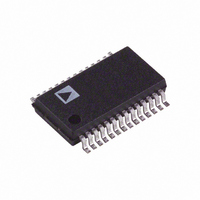ADM3311EARSZ Analog Devices Inc, ADM3311EARSZ Datasheet - Page 15

ADM3311EARSZ
Manufacturer Part Number
ADM3311EARSZ
Description
IC TXRX RS-232 3:5 2.7V 28SSOP
Manufacturer
Analog Devices Inc
Type
Transceiverr
Datasheet
1.ADM3311EARSZ-REEL.pdf
(24 pages)
Specifications of ADM3311EARSZ
Number Of Drivers/receivers
3/5
Protocol
RS232
Voltage - Supply
2.7 V ~ 3.6 V
Mounting Type
Surface Mount
Package / Case
28-SSOP
Device Type
Transceiver
Ic Interface Type
RS232
No. Of Drivers
1
Supply Voltage Range
2.7V To 3.6V
Driver Case Style
SSOP
No. Of Pins
28
Operating Temperature Range
-40°C To +85°C
Lead Free Status / RoHS Status
Lead free / RoHS Compliant
Available stocks
Company
Part Number
Manufacturer
Quantity
Price
Company:
Part Number:
ADM3311EARSZ
Manufacturer:
ADI
Quantity:
19
Company:
Part Number:
ADM3311EARSZ
Manufacturer:
ADI
Quantity:
9 717
Part Number:
ADM3311EARSZ
Manufacturer:
ADI/亚德诺
Quantity:
20 000
Company:
Part Number:
ADM3311EARSZ-REEL
Manufacturer:
ADI
Quantity:
11 223
Part Number:
ADM3311EARSZ-REEL
Manufacturer:
ADI/亚德诺
Quantity:
20 000
Company:
Part Number:
ADM3311EARSZ-REEL7
Manufacturer:
NEC
Quantity:
100
Transmitter (Driver) Section
The drivers convert 3.3 V logic input levels into EIA-232 output
levels. With V
output voltage swing is typically ±6.4 V (or ±5.5 V for
ADM3310E and ADM3315E).
Unused inputs may be left unconnected, because an internal
400 kV pull-up resistor pulls them high forcing the outputs into
a low state. The input pull-up resistors typically source 8 mA
when grounded, so unused inputs should either be connected to
V
consumption.
Receiver Section
The receivers are inverting level shifters that accept RS-232
input levels and translate them into 3.3 V logic output levels.
The inputs have internal 5 kΩ pull-down resistors (22 kΩ for
the ADM3310E) to ground and are also protected against
overvoltages of up to ±30 V. Unconnected inputs are pulled to
0 V by the internal 5 kΩ (or 22 kΩ for the ADM3315E) pull-
down resistor. This, therefore, results in a Logic 1 output level
for unconnected inputs or for inputs connected to GND.
The receivers have Schmitt trigger inputs with a hysteresis level
of 0.14 V. This ensures error-free reception for both noisy
inputs and for inputs with slow transition times.
ENABLE AND SHUTDOWN
The enable function is intended to facilitate data bus
connections where it is desirable to three-state the receiver
outputs. In the disabled mode, all receiver outputs are placed in
a high impedance state. The shutdown function is intended to
shut the device down, thereby minimizing the quiescent
current. In shutdown, all transmitters are disabled. All receivers
are shut down, except for Receiver R3 (ADM3307E,
ADM3312E, and ADM3315E), Receiver R5 (ADM3311E), and
Receiver R4 and Receiver R5 (ADM3310E). Note that disabled
transmitters are not three-stated in shutdown, so it is not
permitted to connect multiple (RS-232) driver outputs together.
The shutdown feature is very useful in battery-operated systems
because it reduces the power consumption to 66 nW. During
shutdown, the charge pump is also disabled. When exiting
shutdown, the charge pump is restarted and it takes
approximately 100 μs for it to reach its steady-state operating
conditions.
CC
or left unconnected in order to minimize power
RECEIVER
OUTPUT
3V
EN INPUT
0V
V
V
OH
CC
OL
= 3.0 V and driving an EIA-232 load, the
Figure 28. Receiver Disable Timing
t
DR
V
V
OH
OL
+ 0.1V
– 0.1V
ADM3307E/ADM3310E/ADM3311E/ADM3312E/ADM3315E
Rev. H | Page 15 of 24
High Baud Rate
The ADM33xxE features high slew rates, permitting data
transmission at rates well in excess of the EIA/RS-232E
specifications. RS-232 voltage levels are maintained at data rates
up to 230 kbps (460 kbps for ADM3307E) under worst-case
loading conditions. This allows for high speed data links
between two terminals.
LAYOUT AND SUPPLY DECOUPLING
Because of the high frequencies at which the ADM33xxE
oscillator operates, particular care should be taken with printed
circuit board layout, with all traces being as short as possible
and C1 to C3 being connected as close to the device as possible.
The use of a ground plane under and around the device is also
highly recommended.
When the oscillator starts up during Green Idle operation, large
current pulses are taken from V
be decoupled with a parallel combination of 10 μF tantalum and
0.1 μF ceramic capacitors, mounted as close to the V
possible.
Capacitor C1 to Capacitor C3 can have values between 0.1 μF and 1
μF. Larger values give lower ripple. These capacitors can be either
electrolytic capacitors chosen for low equivalent series resistance
(ESR) or nonpolarized types, but the use of ceramic types is highly
recommended. If polarized electrolytic capacitors are used, polarity
must be observed (as shown by C1+).
ESD/EFT TRANSIENT PROTECTION SCHEME
The ADM33xxE uses protective clamping structures on all inputs
and outputs that clamp the voltage to a safe level and dissipate the
energy present in ESD (electrostatic) and EFT (electrical fast
transients) discharges. A simplified schematic of the protection
structure is shown in Figure 30 and Figure 31 (see Figure 32 and
Figure 33 for ADM3307E protection structure).
Each input and output contains two back-to-back high speed
clamping diodes. During normal operation with maximum RS-232
signal levels, the diodes have no effect as one or the other is reverse
biased depending on the polarity of the signal. If, however, the
voltage exceeds about ±50 V, reverse breakdown occurs and the
voltage is clamped at this level. The diodes are large p-n junctions
designed to handle the instantaneous current surge that can exceed
several amperes.
RECEIVER
3V
EN INPUT
0V
OUTPUT
V
V
OH
OL
Figure 29. Receiver Enable Timing
t
ER
CC
. For this reason, V
3V
0.4V
CC
CC
pin as
should













